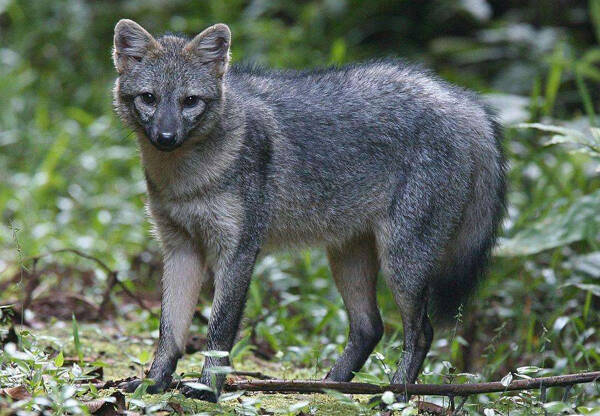Cerdocyon thous
IUCN
LCBasic Information
Scientific classification
- name:Cerdocyon thous
- Scientific Name:Cerdocyon thous,Crab-eating Fox
- Outline:Carnivora
- Family:Schizopoda Canidae Vulpes C.fox
Vital signs
- length:64cm
- Weight:5-8kg
- lifetime:10-12years
Feature
A fox that can suck crabs
Distribution and Habitat
The crab-eating fox is found in Argentina, Bolivia, Brazil, Colombia, Ecuador, French Guiana, Guyana, Panama, Paraguay, Suriname, Uruguay, and the Bolivarian Republic of Venezuela.
The crab-eating fox inhabits subtropical forests and tropical savannahs, and also lives in riparian forests and other places. They migrate to the mountains during the rainy season and return to the lowlands during the dry season. Its habitat covers a variety of environments in addition to rainforests, mountains and vast open grasslands.
Appearance
The crab-eating fox is of medium size. The average head-body length is 64 cm, the shoulder height is 25 cm, the tail length is 28.5 cm, and the weight is 5-8 kg. The fur is short and thick, without patterns. The fur color is mainly gray-brown, with dark blue to dark gray spots. The snout, cheeks, ears, legs and soles are all red, with black stripes on the back and black stripes on the back. There is also black on the ears and tail.
The head and palate are pointed, the face is long, the nose is prominent, the ears are wide and round and upright, the sense of smell is sensitive, and the hearing is well developed. The body is narrow and the limbs are slender. It is digitigrade, with 5 toes on the front feet and 4 toes on the back feet; the claws are thick and blunt, and cannot be retracted or can be slightly retracted. The legs are short and strong, which is conducive to fast running. The tail is long and thickly furred, and it will stand upright when excited.
The canines and carnas
Details
Crab-eating fox (scientific name: Cerdocyon thous) is called Crab-eating Fox in foreign language. There are 5 subspecies.

Crab-eating fox is mainly active at night and also active at dusk, spending the day in caves dug by different animals. Hunting alone or living in pairs. They are monogamous, usually living in pairs or in small groups during the breeding season. Their family territory is 0.6-0.9 square kilometers. In the dry season, they have a strong sense of territory, but in the rainy season when food is abundant, they rarely care about the boundaries of their territory. Crab-eating foxes build their nests in the grass with multiple entrances. They not only dig tunnels, but also invade the nests of other animals.
Crab-eating foxes use different hunting methods depending on different prey. Crab-eating foxes are omnivorous animals. They eat turtles, fruits, eggs, crustaceans, insects, lizards, crabs and carrion. Different seasons and distribution areas also affect their food combination. In the rainy season, they usually eat more crabs and crustaceans; in the dry season, they eat more insects. Crab-eating foxes are very helpful in controlling rodents and harmful insects.
Crab-eating foxes have irregular breeding seasons, but they breed twice a year. They usually start in November-December and July. The gestation period is 56 days, and the offspring are born in January-February. There are about 3-6 pups per litter. The pups are blind and have no teeth. They open their eyes at about 14 days old and can eat solid food after 30 days. They are weaned at about 90 days old. The pups are dark gray at birth, with a lighter belly. Adult male and female foxes will take care of the pups. After 20-35 days, the pups' fur color will become like that of adults. They reach sexual maturity at 9 months old and begin to mark their territory with urine.
In Argentina, the Crab-Eating Fox is considered “not endangered”, as per the 1983 National Directive on Flora and Fauna (Resolution 144), and its exploitation and commercial use were banned in 1987 (Courtenay and Maffei 2004). In all countries, there is no specific legislation for the protection of this species, although hunting of wild animals is prohibited in most countries. In general, there are no specific control regulations for the Crab-Eating Fox, but locally it is a highly unwelcome pest, as it is a natural predator of livestock (poultry and lambs), leading to illegal hunting and the corresponding sale of its fur. In some countries, pest control is subject to specific quotas (no official limits), although the regulations and provisions are often ignored, abused or not enforced. In Uruguay, hunting licenses have not been issued since 1989, as hunting of the fox is negligible (Cravino et al. 1997, 2000).
Listed in the 2015 IUCN Red List of Threatened Species ver 3.1 - Least Concern (LC).
Listed in the CITES Appendix II of the Washington Convention as a protected animal.
Protect wild animals and stop eating game.
Maintaining ecological balance is everyone's responsibility!








